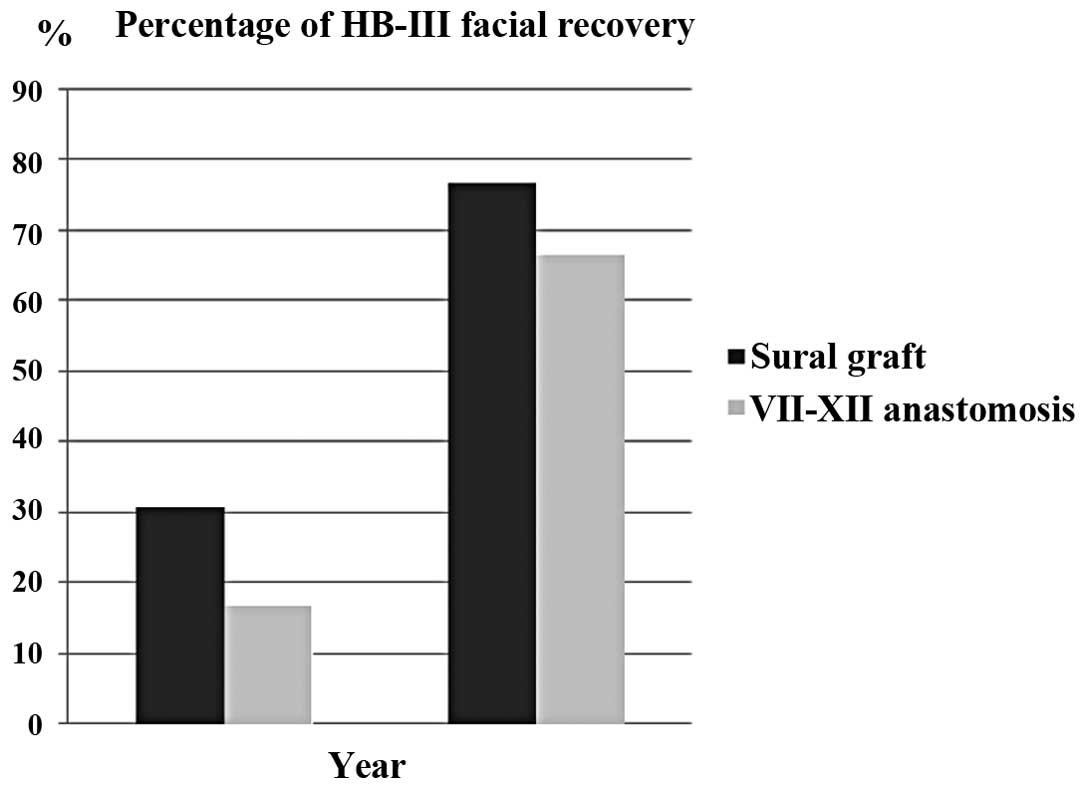Long-term facial nerve function following facial reanimation after translabyrinthine vestibular schwannoma surgery: A comparison between sural grafting and VII-XII anastomosis
- Authors:
- Published online on: May 16, 2013 https://doi.org/10.3892/etm.2013.1120
- Pages: 101-104
Metrics:
Total
Views: 0 (Spandidos Publications: | PMC Statistics:
)
Total PDF Downloads: 0 (Spandidos Publications: | PMC Statistics:
)
Abstract
The aim of this study was to compare the recovery of long‑term facial nerve function between patients who received sural grafts and those who underwent hypoglossal-facial anastomosis techniques following translabyrinthine vestibular schwannoma surgery. This study included 25 patients with vestibular schwannomas treated with translabyrinthine tumor removal. All patients had large tumors with a mean tumor size of 3.12 cm. Of these patients, six had progressive tumor enlargement symptoms and had been treated previously with stereotactic irradiation. Preoperatively, all patients had normal facial functions, and total tumor removal with a translabyrinthine approach was achieved in all cases. During surgery, the facial nerve was interrupted in all 25 patients. Two types of facial reanimation were performed. Sural grafts were placed in 13 patients and hypoglossal-facial (VII-XII) anastomosis was performed in the other 12. Facial nerve function and surgical outcomes were observed upon discharge, in the short term (one year following surgery), and in the long term (three years following surgery). Total facial paresis was observed in all patients upon discharge. In the sural graft group, House-Brackmann grade III facial function was achieved in four patients upon short-term evaluation and in ten upon long-term evaluation, while House-Brackmann grade IV facial function was achieved in nine patients upon short-term evaluation and three in the long term. In the VII-XII anastomosis group, House-Brackmann grade III facial function was achieved in two patients in the short term and eight in the long term, and House-Brackmann grade IV facial function was achieved in ten patients in the short term and four in the long term. There was a statistically significant difference in the facial recovery results between the short- and long-term follow-up periods. The sural graft group exhibited a marked improvement in results compared with the VII-XII anastomosis group, but no statistically significant difference in facial function was observed between the two facial reanimation groups at either the short- or long-term follow-up. In the sural graft group, synkinesia, noted in three patients, was the most frequently observed complication. Claudication was common upon discharge (four patients), but diminished during follow-up. Disarticulation was the most common complication in the VII-XII anastomosis group (five patients); numbness of the tongue was the second most common complication (four patients). None of the patients developed dysphagia. Facial reanimation is an effective procedure for the surgical rehabilitation of static and dynamic facial nerve functions. Significant improvement in facial nerve function may occur more than three years after surgery. Despite morbidities such as synkinesia, the sural graft technique demonstrates greater improvements in facial nerve function than VII-XII anastomosis in the short and long term following surgery, but this conclusion requires confirmation by larger studies with a greater number of patients.











